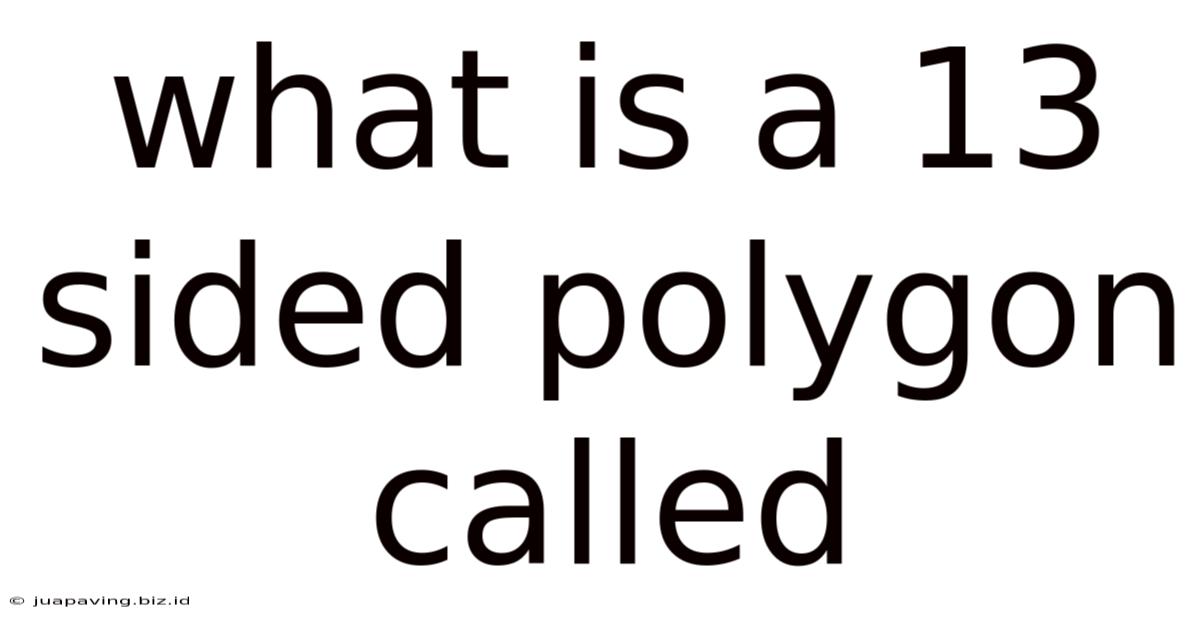What Is A 13 Sided Polygon Called
Juapaving
May 12, 2025 · 4 min read

Table of Contents
What is a 13-Sided Polygon Called? A Deep Dive into Geometry
A polygon is a closed two-dimensional figure formed by connecting line segments end-to-end. Polygons are classified based on the number of sides they possess. While we're all familiar with triangles (3 sides), squares (4 sides), and pentagons (5 sides), the naming conventions for polygons with more sides become less common knowledge. This article will explore the fascinating world of polygons, focusing specifically on the question: what is a 13-sided polygon called? We'll delve into the naming system, explore its properties, and even touch upon some related mathematical concepts.
Understanding Polygon Nomenclature
The naming of polygons follows a relatively consistent system, although it becomes less standardized as the number of sides increases. For polygons with fewer sides, the names are generally derived from Greek prefixes:
- 3 sides: Triangle (tri- meaning three)
- 4 sides: Quadrilateral (quadri- meaning four)
- 5 sides: Pentagon (penta- meaning five)
- 6 sides: Hexagon (hexa- meaning six)
- 7 sides: Heptagon (hepta- meaning seven)
- 8 sides: Octagon (octa- meaning eight)
- 9 sides: Nonagon (also enneagon) (nona- or enne- meaning nine)
- 10 sides: Decagon (deca- meaning ten)
- 11 sides: Hendecagon (also undecagon) (hendeca- or undeca- meaning eleven)
- 12 sides: Dodecagon (dodeca- meaning twelve)
What About 13 Sides? Introducing the Triskaidecagon
As you can probably guess from the pattern, a polygon with 13 sides is called a triskaidecagon. The prefix "triskaideca-" is derived from the Greek words "treis" (three), "kai" (and), and "deka" (ten), literally meaning "thirteen." The term "trisdecagon" is also sometimes used, though less commonly.
Properties of a Triskaidecagon
Like all polygons, a triskaidecagon possesses several key properties:
- Number of sides: 13
- Number of vertices: 13 (a vertex is a point where two sides meet)
- Number of angles: 13 (interior angles)
- Sum of interior angles: The sum of the interior angles of any polygon can be calculated using the formula (n-2) * 180°, where 'n' is the number of sides. For a triskaidecagon, this is (13-2) * 180° = 1980°.
- Regular vs. Irregular: A triskaidecagon can be regular (all sides and angles are equal) or irregular (sides and angles are of varying lengths and measures).
Regular Triskaidecagon: A Deeper Look
A regular triskaidecagon exhibits a high degree of symmetry. Its interior angles are all equal to 1980°/13 ≈ 152.31°. It can be inscribed within a circle, with all its vertices lying on the circumference. This property is crucial in various geometric constructions and calculations. The regular triskaidecagon's symmetry makes it aesthetically pleasing and frequently used in design.
Triskaidecagon in Real-World Applications
While not as ubiquitous as triangles or squares, triskaidecagons can be found, or their principles applied, in various contexts:
- Tessellations: While a regular triskaidecagon cannot tessellate (tile a plane without gaps or overlaps), irregular triskaidecagons can be incorporated into more complex tessellations, creating intricate and visually striking patterns.
- Architecture and Design: Although less common than polygons with fewer sides, the thirteen-sided shape might be used in architectural designs for unique, eye-catching features. The symmetry of a regular triskaidecagon could be exploited for decorative purposes.
- Computer Graphics: Triskaidecagons, like other polygons, are fundamental building blocks in computer graphics, allowing for the creation of complex shapes and models.
- Mathematics and Geometry: Triskaidecagons are used in various mathematical explorations and proofs, especially within the realms of geometry, trigonometry, and topology.
Beyond the Triskaidecagon: Higher-Order Polygons
While the triskaidecagon might seem unusual, polygons with far more sides exist. The naming conventions become less standardized beyond 12 sides. For polygons with a larger number of sides, mathematicians often resort to using the number of sides directly, such as a "17-gon" or a "25-gon."
The Significance of Naming Conventions in Mathematics
The systematic naming of polygons, even for those with many sides, highlights the importance of precision and clarity in mathematics. Consistent terminology enables mathematicians to communicate ideas accurately and unambiguously. The use of Greek prefixes underscores the historical connections between mathematics and classical languages.
Triskaidekaphobia and its Cultural Influence
It's interesting to note that the number 13 holds cultural significance in many societies, often associated with bad luck or superstition. This phenomenon, known as triskaidekaphobia, might subconsciously influence the less frequent use of the term "triskaidecagon" compared to polygons with fewer sides. However, the mathematical properties and applications of the triskaidecagon remain unaffected by these cultural associations.
Conclusion: Embracing the Mathematical Beauty of the Triskaidecagon
The triskaidecagon, a polygon with 13 sides, offers a fascinating case study in the naming and properties of polygons. Although less commonly encountered in everyday life than simpler polygons, understanding its characteristics and applications underscores the beauty and complexity of geometry. The systematic naming convention, even for seemingly less common shapes, emphasizes the importance of precision and clarity in mathematical discourse. From its angular sums to its potential applications in design and computer graphics, the triskaidecagon demonstrates the rich tapestry of mathematical concepts underpinning even the most unconventional shapes. So, the next time you encounter a thirteen-sided figure, remember that it has a name – a somewhat unwieldy but precise name – the triskaidecagon.
Latest Posts
Latest Posts
-
How Many Centimeters Are In 45 Meters
May 12, 2025
-
Shapes With No Line Of Symmetry
May 12, 2025
-
The Breaking Down Of Rocks Is Called
May 12, 2025
-
What Cell Organelle Does Cellular Respiration Occur
May 12, 2025
-
What Is The Difference Between A Simple And Differential Stain
May 12, 2025
Related Post
Thank you for visiting our website which covers about What Is A 13 Sided Polygon Called . We hope the information provided has been useful to you. Feel free to contact us if you have any questions or need further assistance. See you next time and don't miss to bookmark.